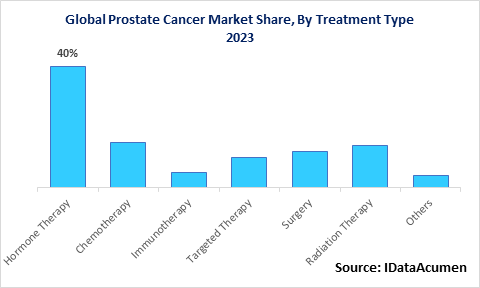The prostate cancer market size is predicted to reach US$ 17.7 billion by 2030, advancing at a CAGR of 8.9% during the forecast timeframe 2023-2030. Prostate cancer is one of the most commonly diagnosed cancers among men, with around 1.4 million new cases and 375,000 deaths reported globally in 2020. It involves abnormal and uncontrolled cell growth in the prostate gland leading to the formation of malignant tumors.
The rising prevalence of prostate cancer worldwide is a key factor driving the growth of this market. According to WHO, the incidence of prostate cancer is expected to increase by 70% across the world by 2040. Other major growth drivers include the growing geriatric population, advancements in screening and early diagnosis, higher awareness, and rapidly emerging treatment options such as targeted therapies, robotic surgeries, immunotherapy, and precision medicine approaches.
North America accounted for the largest share of over 52% of the global prostate cancer market in 2022. Increased spending on research for developing innovative drugs, high adoption of technologically advanced treatments, favorable reimbursements, and greater awareness regarding regular screening are some key aspects supporting the dominant position of North America. Leading companies such as Johnson & Johnson, Pfizer, Merck, AbbVie, and Myovant Sciences have a strong presence in the region.
Europe represented the second largest regional market with a share of around 24% in 2022. The rising burden of prostate cancer, increasing healthcare expenditure, and adoption of advanced therapies such as radiopharmaceuticals are spurring the market growth in this region. Major players operating in Europe include Bayer, Sanofi, Astellas Pharma, Ferring Pharmaceuticals, and Ipsen.
The Asia Pacific market is anticipated to expand at the fastest CAGR during the forecast period owing to various factors like growing preference for minimally invasive procedures, rising investments in healthcare infrastructure, and surging geriatric population in countries like Japan, China, and India.
Key Growth Drivers:
- Escalating Global Prevalence: The worldwide surge in prostate cancer cases, with projections anticipating over 19 million new diagnoses by 2040, is a significant driver propelling market expansion.
- Increasing Adoption of Screening: The growing adoption of regular screening protocols and prostate-specific antigen (PSA) testing for early diagnosis is contributing to the market's growth by facilitating timely detection and intervention.
- Robust Product Pipeline: A strong product pipeline, featuring several highly effective therapies in late-stage clinical development, offers promising prospects for improved treatment options and outcomes.
- Supportive Government Policies: Favorable government policies that endorse fast-track approvals and provide funding for research and development of prostate cancer drugs are bolstering innovation and investment in the market.
Notable Trends:
- Shift Towards Targeted Therapies: A notable trend involves a shift from traditional treatment modalities towards targeted therapies that aim to specifically address the underlying mechanisms of prostate cancer, potentially offering more effective and tailored treatment options.
- Emergence of Precision Medicine: The advent of precision medicine and companion diagnostics is ushering in a new era of personalized treatment approaches, optimizing therapeutic choices based on an individual patient's genetic profile.
- Combination Treatment Regimens: Combination treatment regimens are gaining traction as clinicians explore the synergy of different therapies to enhance treatment efficacy and outcomes.
Opportunities:
- Addressing Unmet Needs: There exists a substantial unmet need for therapies that are better tolerated and cost-effective, offering an opportunity for innovative solutions that can improve the quality of life for prostate cancer patients.
- Immunotherapy Potential: Immunotherapy holds immense potential in the treatment of metastatic prostate cancer, presenting an exciting avenue for research and development in this field.
- Growth in Asia Pacific: Emerging markets in the Asia Pacific region provide ample scope for growth, driven by increasing healthcare awareness and access, making this region a promising frontier for market expansion.
Key Report Insights:
- North America accounted for the largest share of over 52% in 2023, with key players like Johnson & Johnson, Pfizer, and Merck holding dominant positions owing to their blockbuster prostate cancer drugs. Favorable reimbursement policies also enable therapy access.
- Europe represented the second largest share of around 24% in 2023, driven by the high incidence of prostate cancer in countries like the UK, Norway, and others. Companies like Bayer, Sanofi, Astellas Pharma, and Ipsen are key players in this region.
- Leading companies operating in the global prostate cancer market include Johnson & Johnson, Pfizer, Astellas Pharma, AstraZeneca, Novartis, Bayer, Merck, Sanofi, AbbVie, Ferring Pharmaceuticals, and Bristol Myers Squibb.

Prostate Cancer Market Segmentation:
- By Treatment Type
- Hormone Therapy
- Chemotherapy
- Immunotherapy
- Targeted Therapy
- Surgery
- Radiation Therapy
- Others
- By End User
- Hospitals
- Cancer Research Institutes
- Ambulatory Surgical Centers
- Others
- By Distribution Channel
- Hospital Pharmacies
- Retail Pharmacies
- Online Pharmacies
- By Stage
- Localized
- Locally Advanced
- Metastatic
- Castration-Resistant
- By Region
- North America
- Europe
- Asia Pacific
- Latin America
- Middle East & Africa
Definition:
“The prostate cancer therapeutics market encompasses drugs, medical devices, therapies, and services used for treating prostate cancer conditions in patients. Prostate cancer involves abnormal and uncontrolled cell growth in the prostate gland of men. Treatment options include hormone therapy, chemotherapy, immunotherapy, radiation therapy, surgery, gene therapy, cryotherapy, and others. The market comprises pharmaceutical drugs, robotic surgery devices, radiation devices, imaging systems, therapeutic cancer vaccines, and other technologies used in prostate cancer treatment.”